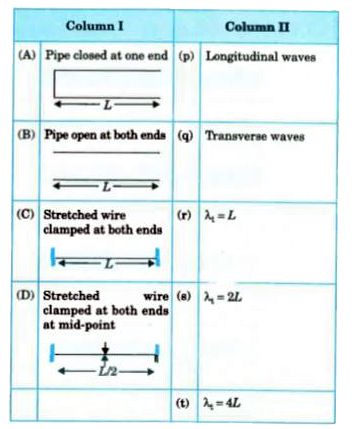MATRIX MATCH TYPE QUESTIONS from MODERN PUBLISHERS PHYSICS Chapter 30 WAVES for Class 11
| Class 11 | PHYSICS |
| Chapter | WAVES |
| MODERN PUBLISHERS PHYSICS | MATRIX MATCH TYPE QUESTIONS |
| Medium | English |
| Academic Year | 2023-2024 |
Question 1
Column IColumn II(A)For a stationary wave(p)Vibrations are perpendicular to direction to wave propagation(B)For a longitudinal wave(q)Amplitude of vibrations changes with time(C)For a transverse wave(r)Amplitude of vibration does not change with time(D)For a progressive wave(s)Vibrations are along the direction of wave propagation(t)Nodes and antinoes are formedView SolutionQuestion 3
Column I shows four systems, each of the same length L, for producing standing waves. The lowest possible natural frequency of a system is called it fundamental frequency, whose wavelength is denoted as λt. Match each system with statements given in Column II describing the nature and wavelength of the standing waves.
 View Solution
View Solution
All Exercises from MODERN PUBLISHERS PHYSICS Class 11 PHYSICS WAVES
- ASSERTION REASON TYPE QUESTIONS
- CHAPTER PRACTICE TEST
- CONCEPTUAL QUESTIONS
- EXAMPLE
- HIGH ORDER THINKING SKILLS & ADVANCED LEVEL
- INTEGER TYPE QUESTION
- MATCHING TYPE QUESTIONS
- MATRIX MATCH TYPE QUESTIONS
- MULTIPLE CHOICE QUESTIONS
- NCERT ADDITIONAL EXERCISES
- NCERT EXEMPLAR PROBLEMS
- NCERT TEXTBOOK EXERCISES
- PRACTICE PROBLEMS
- PROBLEM
- REVISION EXERCISES